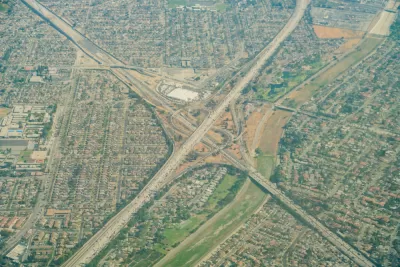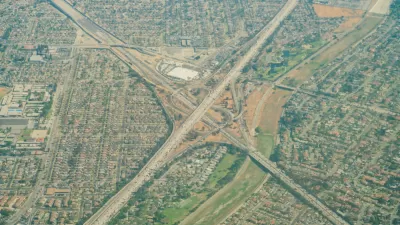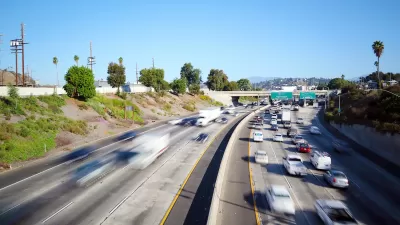Advocates are calling out regional and state transportation planning agencies for a failure of racial justice as plans to widen a freeway in Southern California move forward.

Joe Linton reports: "The full details are not yet entirely clear, but Metro and Caltrans are finalizing plans to widen portions of the 605 and 5 Freeways – and the project will destroy hundreds of homes, primarily in the city of Downey."
The "I-605 Corridor Improvement Project," as it's known at the Los Angeles County Metropolitan Transportation Authority (Metro) would work on portions of the I-5, I-10, I-105, and California State Route 60, in addition to I-605, while crossing jurisdictional lines and touching nine cities and additional unincorporated areas, according to Linton.
The possibility of the highway widening encroaching on existing residential properties is found in the project alternatives from an August presentation for Metro’s $10 billion SR-91/I-605/I-405 “Hot Spots” Program. All three of the current project alternatives under consideration by metro would add two additional lanes to each side of the 605 Freeway, according to Linton.
A chart in the presentation lists the number of parcels to be acquired by Metro and Caltrans to make space for the new lanes: 360+ full acquisitions, 320+ partial acquisitions, and 540+ easements.
Linton gives a hat tip to Downey resident Alexandria Contreras, who raised the alarm about the project's plans to expand into existing private properties via Twitter. Mainstream local news has also picked up the story, like this on-air report by NBC Los Angeles.
A lot more detail, maps, and soundbites are found in the source article.
FULL STORY: Metro Plans to Take Out 200+ Downey Homes to Widen 5 and 605 Freeways

Study: Maui’s Plan to Convert Vacation Rentals to Long-Term Housing Could Cause Nearly $1 Billion Economic Loss
The plan would reduce visitor accommodation by 25,% resulting in 1,900 jobs lost.

North Texas Transit Leaders Tout Benefits of TOD for Growing Region
At a summit focused on transit-oriented development, policymakers discussed how North Texas’ expanded light rail system can serve as a tool for economic growth.

Using Old Oil and Gas Wells for Green Energy Storage
Penn State researchers have found that repurposing abandoned oil and gas wells for geothermal-assisted compressed-air energy storage can boost efficiency, reduce environmental risks, and support clean energy and job transitions.

Texas State Bills Could Kill Transit Funding in Dallas, Austin
State lawmakers could pull funding from the state’s largest transit agency and the ambitious Project Connect, a voter-approved transit project in Austin.

Opinion: DC Encampment Sweeps Hide, but Don’t Solve, Homelessness
President Trump recently ordered the clearing of encampments built by unhoused people on federal land in Washington, D.C.

Santa Barbara Could Build Housing on County Land
County supervisors moved forward a proposal to build workforce housing on two county-owned parcels.
Urban Design for Planners 1: Software Tools
This six-course series explores essential urban design concepts using open source software and equips planners with the tools they need to participate fully in the urban design process.
Planning for Universal Design
Learn the tools for implementing Universal Design in planning regulations.
Ascent Environmental
Borough of Carlisle
Institute for Housing and Urban Development Studies (IHS)
City of Grandview
Harvard GSD Executive Education
Toledo-Lucas County Plan Commissions
Salt Lake City
NYU Wagner Graduate School of Public Service





























